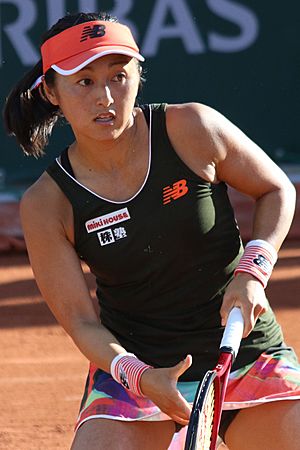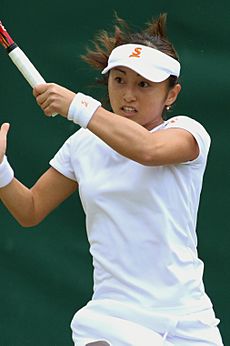Misaki Doi facts for kids

Doi at the 2021 French Open
|
|
| Country (sports) | |
|---|---|
| Residence | Tokyo, Japan |
| Born | 29 April 1991 Ōamishirasato, Japan |
| Height | 1.59 m (5 ft 3 in) |
| Turned pro | 2006 |
| Retired | September 2023 |
| Plays | Left (two-handed backhand) |
| Coach | Christian Zahalka |
| Prize money | US$ 3,946,733 |
| Singles | |
| Career record | 404–378 (51.66%) |
| Career titles | 1 |
| Highest ranking | No. 30 (10 October 2016) |
| Grand Slam singles results | |
| Australian Open | 2R (2013) |
| French Open | 2R (2015) |
| Wimbledon | 4R (2016) |
| US Open | 2R (2015, 2021) |
| Other tournaments | |
| Olympic Games | 2R (2021) |
| Doubles | |
| Career record | 148–119 (55.43%) |
| Career titles | 2 |
| Highest ranking | No. 77 (24 May 2021) |
| Grand Slam doubles results | |
| Australian Open | 2R (2020) |
| French Open | 3R (2022) |
| Wimbledon | 2R (2017, 2021) |
| US Open | 2R (2017) |
| Team competitions | |
| Fed Cup | 11–12 (47.83%) |
Misaki Doi (土居 美咲, Doi Misaki, born 29 April 1991) is a Japanese former professional tennis player. She was known for her strong left-handed play.
Misaki reached two junior Grand Slam doubles finals. These were at Wimbledon in 2007 and the Australian Open in 2008. She also played in three WTA (Women's Tennis Association) tournament finals, winning one of them.
Contents
Early Tennis Years
Misaki Doi started playing tennis when she was six years old. She quickly showed talent, especially during her middle school years. In 2004 and 2006, she reached the semifinals of the All Japan Middle School Tennis Championships. She joined the ITF Junior Circuit in 2006, which is a series of tournaments for young players.
In 2007, Misaki came in second place at the Japan Open Junior Championships. This showed she was one of Japan's rising young tennis stars.
Junior Doubles Success
A big part of Misaki's junior career was her doubles partnership with Kurumi Nara. In 2007, they finished second in girls' doubles at Wimbledon. This was a big achievement for a Japanese pair. They continued to do well, reaching semifinals at the US Open and Wimbledon 2008.
Misaki also teamed up with Elena Bogdan from Romania. They finished second in girls' doubles at the 2008 Australian Open. These successes helped Misaki become one of the top junior players in Japan.
Becoming a Professional Player
Misaki Doi officially became a professional tennis player in June 2006, when she was 15.
First Professional Wins (2009)
In 2009, Misaki mostly played in tournaments in Japan. She won her first ITF (International Tennis Federation) title in March 2009. This win helped her ranking improve a lot. By the end of 2009, she was among the top 10 players in Japanese tennis.
Playing in Grand Slams (2010)
In 2010, Misaki started playing in bigger tournaments outside Japan. She played in the qualifying rounds for the 2010 Australian Open. She also won her first doubles title at the Fukuoka International Women's Cup with her partner Kotomi Takahata.
Misaki then qualified for her first major tournament, the 2010 French Open. This was a big step in her career. She finished the year by winning the All Japan Tennis Championships in singles.
First Major Win (2011)
Misaki's performance in Grand Slams got better in 2011. She qualified for Wimbledon 2011 and won her first match in a Grand Slam. She even won another match before losing in the third round.
Reaching WTA Quarterfinals (2012)
In 2012, Misaki reached the quarterfinals of a singles tournament for the first time at the Birmingham Classic. She beat a top player, Francesca Schiavone, to get there. Later that year, she reached her first tour semifinal at the Japan Women's Open.
Playing All Major Tournaments (2013)
The year 2013 was special because Misaki qualified for all four Grand Slam tournaments. These are the Australian Open, French Open, Wimbledon, and US Open. She reached the second round of the Australian Open that year.
Wimbledon Success and Top 30 Ranking (2016)
At the 2016 Australian Open, Misaki played a very close match against Angelique Kerber, who later won the tournament. Misaki reached a new career-high ranking of world No. 38 in May 2016.
Her best Grand Slam result came at Wimbledon that year. She reached the fourth round, which was a great achievement. She was the first Japanese female player to reach this stage at Wimbledon in ten years. In October 2016, she entered the top 30 players in the world.
Challenges and Comebacks (2017-2019)
After 2016, Misaki faced some challenges and her ranking dropped. She worked hard to get back to her best. In 2018, she won an ITF event in Vancouver, which helped her ranking improve a lot.
In 2019, Misaki showed great form again. She qualified for the 2019 Australian Open main draw. She also had a big win at the Bastad Open, winning her last WTA Tour title. This win pushed her back into the top 100 rankings. She ended 2019 ranked 74th in the world.
Later Career and Retirement (2020-2023)
In 2020, the COVID-19 pandemic affected the tennis tour. Misaki continued to play, reaching a final at a WTA Challenger event in Indian Wells.
In 2022, she won a doubles title at the Swedish Open with her partner Rebecca Peterson.
In August 2023, Misaki Doi announced that she was retiring from professional tennis. This was due to ongoing back injuries. She played her final tournaments in Japan, at the 2023 Japan Women's Open and the Pan Pacific Open.
Personal Information
Misaki Doi's coach since April 2015 was Christian Zahalka. She admired tennis players like Justine Henin and Shingo Kunieda. Misaki preferred playing on hardcourts and was known for her strong forehand and serve.
Career Highlights
Misaki Doi played in many tournaments throughout her career. Here are some of her main achievements:
Singles Performance
Misaki played in all four Grand Slam tournaments many times. Her best results were reaching the second round at the Australian Open and US Open, and the fourth round at Wimbledon.
| Tournament | 2010 | 2011 | 2012 | 2013 | 2014 | 2015 | 2016 | 2017 | 2018 | 2019 | 2020 | 2021 | 2022 | 2023 | Titles | Wins–Losses |
|---|---|---|---|---|---|---|---|---|---|---|---|---|---|---|---|---|
| Grand Slam tournaments | ||||||||||||||||
| Australian Open | Q1 | Q2 | Q1 | 2R | 1R | Q2 | 1R | 1R | Q1 | 1R | 1R | 1R | 1R | Q2 | 0 | 1–8 |
| French Open | 1R | A | A | 1R | 1R | 2R | 1R | 1R | Q1 | 1R | 1R | 1R | 1R | 0 | 1–10 | |
| Wimbledon | Q3 | 3R | 1R | 1R | 2R | 1R | 4R | 1R | A | Q2 | NH | 1R | 1R | 0 | 6–9 | |
| US Open | Q2 | 1R | A | 1R | 1R | 2R | 1R | 1R | Q1 | 1R | 1R | 2R | Q3 | 0 | 2–9 | |
| Overall Grand Slam Record | 0–1 | 2–2 | 0–1 | 1–4 | 1–4 | 2–3 | 3–4 | 0–4 | 0–0 | 0–3 | 0–3 | 1–4 | 0–3 | 0–0 | 0 / 36 | 10–36 |
Doubles Performance
Misaki also played in doubles tournaments at the Grand Slams.
| Tournament | 2013 | 2014 | 2015 | 2016 | 2017 | ... | 2020 | 2021 | 2022 | Titles | Wins–Losses |
|---|---|---|---|---|---|---|---|---|---|---|---|
| Australian Open | 1R | 1R | A | 1R | 1R | 3R | 1R | A | 0 | 2–6 | |
| French Open | 2R | A | A | 2R | 1R | 2R | 2R | 3R | 0 | 6–6 | |
| Wimbledon | A | A | 1R | 2R | 2R | NH | 2R | 0 | 3–4 | ||
| US Open | A | 2R | A | 1R | 2R | A | 1R | 0 | 2–4 | ||
| Overall Grand Slam Doubles Record | 1–2 | 1–2 | 0–1 | 2–4 | 2–4 | 3–2 | 2–4 | 2–1 | 0 / 20 | 13–20 |
WTA Tour Finals
Misaki Doi reached three singles finals and three doubles finals on the WTA Tour.
Singles Finals: 3 (1 title, 2 runner-ups)
Misaki won one singles title and was the runner-up twice.
| Result | W–L | Date | Tournament | Surface | Opponent | Score |
|---|---|---|---|---|---|---|
| Win | 1–0 | Oct 2015 | Luxembourg Open | Hard (indoor) | 6–4, 6–7(7–9), 6–0 | |
| Loss | 1–1 | Feb 2016 | Taiwan Open | Hard | 4–6, 2–6 | |
| Loss | 1–2 | Sep 2019 | Japan Women's Open | Hard | 3–6, 2–6 |
Doubles Finals: 3 (2 titles, 1 runner-up)
Misaki won two doubles titles and was the runner-up once.
| Result | W–L | Date | Tournament | Surface | Partner | Opponents | Score |
|---|---|---|---|---|---|---|---|
| Win | 1–0 | Jul 2014 | İstanbul Cup | Hard | 6–4, 6–0 | ||
| Loss | 1–1 | Sep 2015 | Japan Women's Open | Hard | 1–6, 2–6 | ||
| Win | 2–1 | Sep 2019 | Japan Women's Open | Hard | 3–6, 6–4, [10–4] |
Wins Against Top 10 Players
Misaki Doi had one win against a player ranked in the top 10 in the world.
| # | Player | Rank | Event | Surface | Round | Score |
|---|---|---|---|---|---|---|
| 1. | No. 10 | Madrid Open, Spain | Clay | 1R | 6–4, 4–6, 6–4 |
See also
 In Spanish: Misaki Doi para niños
In Spanish: Misaki Doi para niños


